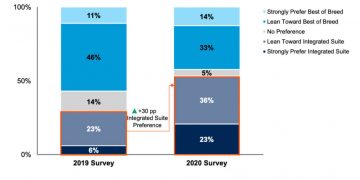How did Outreach grow in just a few years to 50,000 monthly active users, $10 million in new bookings, and net revenue retention (NRR) of more than 140%?
By focusing intently on a single measurement, known as a north star metric.
The sales platform is intensely devoted to nurturing its monthly active users (MAU). They even employ a dedicated “System Implementation Manager” whose sole responsibility is to drive adoption and get 70% of customers using the product daily.
The north star metric defines success for the whole company and aligns teams on a growth trajectory.
In this article, you’ll learn how other growing companies use the north star metric to achieve customer success. Apply these lessons to align your teams and drive revenue growth.
What is a north star metric and why does it matter?
Your north star metric (NSM) is the single measurement that is most indicative of your company’s long-term success.
Rather than tracking several metrics across multiple teams, brands that use the north star metric model identify a single measure that indicates overall company success and encompasses all other potential measurements.
“When the sales and marketing teams are looking at the same metrics and trying to hit the same North Star, lots of other pieces of ABM [account based marketing] fall into place.” – Samantha Mayer, Sales Manager, SMB and Pardot Growth Marketing
The idea is simple: align all teams toward a single goal to make collaboration and communication easier.
The NSM model drives:
- Team alignment and focus. Having a single shared goal reduces instances where departments overlap or work against each other.
- Transparency and ease of reporting and analysis. Weekly and monthly progress reports are easy to digest, and are consistent across the entire company.
- Customer-centricity. North star metrics are inherently customer-centric, meaning all teams become focused on customer success rather than closing deals or growing revenue (although these naturally follow).
- Accountability. NSMs can be broken down into sub-metrics (more on that later), so each team and individual can be held accountable for specific outcomes that influence north star metric growth.
True north star metrics tick three critical boxes. NSM must:
- Lead to revenue;
- Reflect customer value;
- Measure progress.
Let’s take a deeper look at each component with some examples that Finmark compiled in their list of 80+ SaaS companies using a north star metric.
North star metrics must lead to revenue
Company success is largely defined by revenue growth, but revenue itself isn’t enough to be your NSM. Instead, your north star metric should be a variable that feeds into revenue.
Uber’s NSM, “number of trips,” is a good example of this; more trips mean more revenue.
North star metrics must reflect customer value
Your NSM must be indicative of the value customers receive from your product. If it improves, your customers get more value from your product.
Metrics such as daily active users (DAU), customer lifetime value (LTV), and Jira’s “active paid users” are all good examples of north star metrics that reflect customer value.
“Revenue is the price your customer pays. North star metric is the value your customer gets in return for that price.” – Ward van Gasteren, Growth Hacking Coach [via Grow with Ward]
North star metrics must measure progress
This is true of all good metrics. NSMs must be easily measurable, and their growth must reflect general company progress.
Take Asana. Their north star metric “weekly active paid users” strongly reflects progress. An increase in this metric means the company’s customer base is growing, as is revenue.
Where brands go wrong with north star metrics
North star metrics are incredible for alignment and evaluating your value to customers, but you can’t just set your sights on a metric, call it your north star, and expect results.
1. Defaulting to revenue
Revenue (or any similar metric, such as ARR, Gross Merchandise Sales, or Monthly Billings) is not a suitable NSM for several reasons:
- It’s a lagging indicator. Revenue tells you what happened in the past, not what will happen in the future. You want your NSM to be a leading indicator.
- It’s not representative of customer value. Revenue is the value you receive from customers, not the value they receive from you.
- It’s hard to operationalize. Because revenue can be inconsistent, operationalizing it as an NSM can be challenging, making it hard to link to your employee’s daily activities.
- It changes your focus. Looking solely at revenue means trying to extract as much revenue from each customer as possible rather than building a product that provides the most value (and therefore allows you to charge more, keep customers for longer, etc.).
- It’s uninspiring. Your NSM should foster team engagement and interest. Revenue is quite far removed from most employees’ daily jobs, and big numbers (in the millions) are hard to grasp compared to a metric like monthly active users (MAU).
2. Sticking too rigidly to a north star metric
Let’s say your startup is using monthly active users as your NSM. It’s been good for measuring growth so far, but you’ve identified that 80% of your users are on the free plan, and it’s time to focus on conversion.
MAU is no longer going to be a suitable NSM for your company. This number can grow, but if all your new MAUs are free users, you’re not achieving your conversion and paid customer acquisition goals.
NSMs should be used long-term, but you can opt to change your key metric when your old one no longer reflects company objectives or if your business model changes.
3. Focusing too narrowly on the NSM
The north star metric model is just that: a model.
The idea is to align all teams under a single metric that reflects company success, but you shouldn’t do away with other measurements altogether.
Teams still need to understand what defines success for them each month, week, and day.
Don’t forgo all other measurements in favor of an NSM. Do make sure your team and individual metrics feed into your north star.
Take Outreach’s NSM, monthly active users.
To achieve this, sales will need to focus on metrics such as conversion rate and average deal size (measured in users). Marketing will need to focus on lead generation (new MQLs), and customer success will need to drive retention and feature adoption.
The Customer Success Manager is responsible for “going deep” and increasing the average number of features used by each user. – Manny Medina, Outreach CEO [via Latka]
Each of these team metrics has a direct impact on NSM growth.
North Star Metric (NSM) vs. One Metric That Matters (OMTM)
Another commonly used model for simplifying the measurement of progress is One Metric That Matters (OMTM). OMTM and NSM are not synonyms.
NSM is a long-term tool used to measure company growth across the board. OMTM is a short-term metric (generally used for two to six months) and tends to be departmental.
For example, a digital team at an ecommerce brand might focus on shopping cart abandonment rate as an OMTM, while the company’s NSM is “number of monthly transactions.”
In this instance, the OMTM feeds into the company’s NSM. By reducing cart abandonment rates, the company will influence sales and drive progress toward their north star metric.
What are some examples of good north star metrics?
The best-performing companies use north star metrics to understand progress in one of five areas:
- Growth efficiency;
- Customer acquisition;
- Custom action;
- Usage;
- User experience.
Use these examples to help choose the right north star metric for your company stage and objectives.
North star metric for growth efficiency
Calm, a mediation and mindfulness app, uses the north star metric model to measure its brand’s growth efficiency.
They focus on two metrics:
- Customer lifetime value (LTV). The total revenue they’ll receive from a given customer throughout their business relationship.
- Customer acquisition cost (CAC). The average marketing and sales cost to win a new client.
LTV is a great NSM for measuring growth efficiency. It’s inextricably linked to revenue, as higher LTVs = more revenue.
It reflects customer value in that buyers who get great value from a product will stay longer, increasing LTV. And it’s the perfect measure of progress because a growing LTV indicates that the product offering (and customer success initiatives) are improving.
The relationship between LTV and CAC is also an important one.
If Calm continues to increase LTV, then CAC can increase, allowing the platform to outcompete other apps in the space by investing more in advertising, brand awareness, and social media engagement.
North star metric for customer acquisition
Airtable understands the need for specificity when choosing a north star metric to measure customer acquisition.
Rather than looking at total WAU (weekly active users), Airtable narrows down to track weekly paid users, or WPU (removing free plan and trial users from the calculation).
This NSM is much more directly tied to revenue; when WPU increases, revenue increases. It’s also highly reflective of customer value, as Airtable needs to demonstrate just how impactful its product is in order to convert free and trial users over to paid memberships.
And undoubtedly, WPU is a great proxy for progress, as you can measure advancement regularly and incrementally.
When choosing a north star metric to measure customer acquisition, consider whether your goal is to attract only paid users or simply to grow your customer base overall. Then select the metric that best represents this goal (WAU or WPU).
North star metric for customer action
Super customer-focused companies can base north star metrics on specific customer actions, like consumption.
Take video platform Loom. Rather than measuring annual revenue or monthly active users, Loom gets super narrow, naming the videos with a view as its NSM.
Loom customers use the product to create screen share videos and other video content, often in an educational or business setting. By focusing on videos with a view, Loom becomes invested in the same thing their customers are, getting seen.
Clearly, this north star metric reflects customer value (more videos viewed indicates customers are using Loom), but it’s also causally linked to revenue.
Loom users who record more videos see value from the product’s functionality and are less likely to churn. They’ll also need to upgrade their subscription one day to get more videos and make them longer.
North star metric for usage
There are many ways we can measure usage. Some examples for north star metrics include:
- Weekly Querying Users;
- Total Engaged Time;
- Social Engagement.
The most common, however, are daily, weekly, and monthly active users (DAU, WAU, and MAU, respectively).
Active users are a better metric for growth than new users because they’re a leading indicator. These users are the ones getting value out of your product. They’re less likely to churn and more likely to become brand advocates.
New customers, on the other hand, are a risk factor. Closing a deal is only half the battle; retaining that customer is what matters for revenue.
Using monthly, weekly, or daily active users as your NSM changes your focus.
Marketing becomes concerned with creating powerful onboarding and customer education sequences. Sales and support focus on building relationships and ensuring smooth delivery and handoff. Success becomes fixated not just on immediate adoption but on long-term usage.
North star metric for user experience
Email client Superhuman chose one of the most widely-used and easily-understood customer experience metrics for their NSM: net promoter score.
Net promoter score (NPS) analyzes customer sentiment at various stages in the customer journey based on their response to a simple question:
“On a scale from one to ten, how likely would you be to recommend our brand to a friend or family member?”
Customers don’t need to justify their response (though you may give them an opportunity); they simply choose a number on the scale, which bodes well for survey engagement.
Then, brands sort responses into one of three categories:
- Promoters (those who score 9 or 10);
- Passives (those who score 7 or 8);
- Detractors (those who score 6 or less).
To calculate NPS, subtract the percentage of detractors from the percentage of promoters (e.g., 70% promoters – 10% detractors = NPS score of 60%).
Net promoter score is a great candidate for a north star metric because it excels in all requirements:
- It leads to revenue (happy customers are returning customers).
- It reflects customer value (those who rate you highly have enjoyed their experience).
- It measures progress (increasing NPS leads to better customer retention and revenue growth).
Should a company only have one north star?
Strictly speaking, the point of the north star metric framework is to distill your company’s growth measurements down to a single metric.
In theory, then, the goal is to have just one.
In practice, however, this can be limiting, particularly for large organizations. It’s not uncommon for enterprise-level companies to monitor multiple north star metrics.
Importantly, you still need to avoid siloing departments by having one metric per team. If you must use more than one NSM, make sure they’re all metrics that every department can influence.
Take Spotify, which uses three north star metrics:
- Number of paid subscribers;
- Consumption hours (for Podcasts);
- Monthly active users.
All team members can influence MAU, and as we’ve said above, it reflects customer value. It doesn’t, however, map directly over to revenue (more than half of Spotify’s customers are on a free plan).
It makes sense, then, for Spotify to supplement MAU with an acquisition metric: the number of paid subscribers.
In short, it’s fine to have more than one north star metric if it’s not possible for you to distill down to one metric that defines company success.
How do you select a good north star?
Follow these steps to gradually narrow down from a broad understanding of business needs to a single measurement that reflects overall progress.
1. What factors are essential to our company’s success?
First, analyze and list the various factors that contribute to company success. Think broadly here.
Take Medium. As an open publishing platform, Medium really has two types of customers: readers and writers.
“I sometimes characterize Medium as content matchmaking: we want people to write, and others to read, great posts. It’s two-sided: one can’t exist without the other.” – Pete Davies, Product Lead, Medium
For Medium, then, essential factors to success might include new publications, membership renewals, or brand awareness.
2. Which KPIs measure these?
Now, turn these factors into hard measurements. Ask, how can we measure each of the essential factors identified?
For Medium, important KPIs might include:
- Weekly page views;
- Monthly new signups;
- Total number of live posts;
- Total reading time;
- Monthly active users;
- Average time on page per session;
- Monthly recurring revenue;
- Social media shares.
3. Of the above, which are the most crucial?
Now, cut out the “nice to have” metrics and keep only the most critical to your business’ success.
Medium, for instance, may determine that “Total number of live posts,” “Total reading time,” and “Monthly active users” are the three most important measurements.
4. What one metric encapsulates all of those?
Lastly, determine the single metric that encapsulates all of the most crucial measurements. For Medium, it’s total time reading.
“The aggregate Total Time Reading (TTR) is a metric that helps us understand how the Medium platform is doing as a whole. We can slice that number in lots of ways (logged-in vs. logged-out, new posts vs. old, etc.).” – Pete Davies
TTR works for Medium because all of the other measurements feed into it. More MAUs mean more readers to drive TTR upward, and more published pages mean more content for active users to read.
How to use the north star to drive product strategy
The point of a north star metric is to align all teams on a single mission, such that sales, marketing, service, success, and product teams all share the same vision for success.
So, simply tracking the metric is insufficient; product teams must invest in experimentation to drive their NSM upward.
Take Webflow, a no-code website development platform.
Webflow is deeply focused on customer acquisition, using the number of paid subscribers as their north star metric.
So, how can a product manager at Webflow use their NSM to drive developments in their product strategy?
Analyze customer segments and double down on high-converting audiences
If Webflow’s primary goal is to increase paid subscribers, the first step is to analyze its current customer base to understand which segments:
- Convert most easily;
- Stay the longest;
- Become product evangelists.
As a web design platform, Webflow likely has two main customer types: brands (individuals and companies designing a website internally) and designers (agencies, freelancers, and contractors).
Assuming the latter is the more lucrative segment (they’re more likely to be paid subscribers), Webflow can dig deeper to understand trends in industry and region.
For instance, tech-focused website designers in the Pacific Northwest may present the biggest opportunity. Webflow’s acquisition team can double down on geo-targeted ads with messaging aimed at tech designers.
Optimize the trial and onboarding process
Webflow’s acquisition funnel starts with a free plan. Because they don’t start charging until you actually publish a website, there’s no free trial, and signing up takes less than a minute (with a Google account).
There are no barriers to customer acquisition, meaning it’s all on the onboarding process for converting free users into paid ones.
Webflow’s welcome email is good, but it’s busy, sharing four resources (with CTAs for each):
- Prebuilt layouts;
- Templates;
- Webflow 101;
- Hire an Expert.

A marketer at Webflow could design an experiment to test whether a more personalized onboarding sequence is more effective.
A simple question (e.g., “How would you like to get started?”) with a multi-choice answer (e.g., “Get help from an expert” and “Start with a template”) could be added to the sign-up sequence.
You could then send a corresponding welcome email that includes only the resources that particular user needs.
Experiment with different pricing and package structures
Webflow’s pricing structure may be a barrier to growing paid accounts.
Free users get up to 50 CMS items included in their plan, but when they upgrade to Basic, this drops to zero, forcing users to jump straight into a more expensive plan.
To drive paid user acquisition, a pricing manager at Webflow could experiment with upping the CMS item cap on the Basic plan to 50 (the same as the free plan).
Conclusion
Successful brands, big and small, use the north star metric system to inform their growth strategy, focus on customer success, and align teams on a single mission.
But NSM growth doesn’t happen in a vacuum. It occurs when marketing and sales align with the product team to build a custom experience that attracts and retains paying customers.
Become great at product marketing and drive NSM progress with CXL’s Product Marketing Minidegree.
Read the full article here














